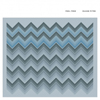 Pitre's latest composition is certainly an impressive and mesmerizing one, but it is quite a daunting challenge to find words to describe quite why it works so well.  Built around computer-randomized patterns of harmonics and fleshed out by a sextet of strings and dulcimer, Feel Free's beauty lies in its rippling, organic near-stasis: this is classical music blurred, stretched, and rendered in such a pointillist fashion as to seem like a languid, blissful, and formless haze.
Pitre's latest composition is certainly an impressive and mesmerizing one, but it is quite a daunting challenge to find words to describe quite why it works so well.  Built around computer-randomized patterns of harmonics and fleshed out by a sextet of strings and dulcimer, Feel Free's beauty lies in its rippling, organic near-stasis: this is classical music blurred, stretched, and rendered in such a pointillist fashion as to seem like a languid, blissful, and formless haze.
Basing a serious composition upon randomness and chance is certainly nothing new, as John Cage began taking direction from the I Ching as far back as the early '50s.  However, Feel Free might be the most listenable probability-based music that I have heard.  A lot of that certainly has to do the fact that this five-part piece is not purely steered by the vagaries of chance: the random harmonics all seem to fall within a single key and they are merely one part of a work that also contains composed and improvised motifs.  Still, those twinkling, unpredictable harmonics are the single most important part of Feel Free–their strange, unreliable rhythm and ever-shifting harmonies paradoxically provide the piece's only real framework, even if it is as fragile and space-filled as a spiderweb.
Such a gambit, obviously, is only possible when it is executed deftly and ingeniously and Pitre scores on both counts.  For one, despite being computer-randomized, the central harmonics were originally played by an actual person (Pitre) on a guitar and sound very natural–and quite pleasant too (harmonics are pretty inherently likable and chiming).  Conversely, the various violin, cello, harp, contrabass, and dulcimer parts played by Pitre's ensemble sound pretty random despite being played by actual people in real-time according to a score (except where Duane urged them to "feel free" to interact with or ignore their aural surroundings).  Not "random" in any jagged, cacophonous kind of way, mind you, but the amorphous, organic unfolding of plucks and swells feels naturally occurring rather than deliberate (though a number of non-traditional crescendos and confluences snuck up on me to keep it all dynamically absorbing).
While I certainly admire his stealth and fluidity as a composer, it is the blurring of computer and human (and the premeditated and the unexpected) into a single woozy, soft-focus middle ground that is Duane's real masterstroke, yielding a seamless, gently swaying tapestry of sublime, droning beauty.  In a way, Feel Free is a weirdly perfect piece of music: it is complexly textured and imbued with genuine, deep pathos (particularly in the violins), but it is so off-kilter, mysterious, and devoid of any strong melodic motifs that it can probably be endlessly looped without ever becoming boring.
Samples:
 
Read More

